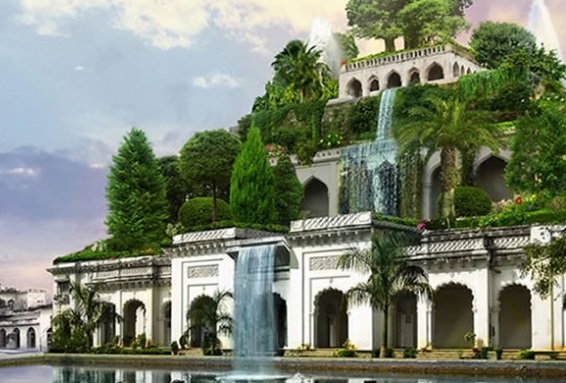

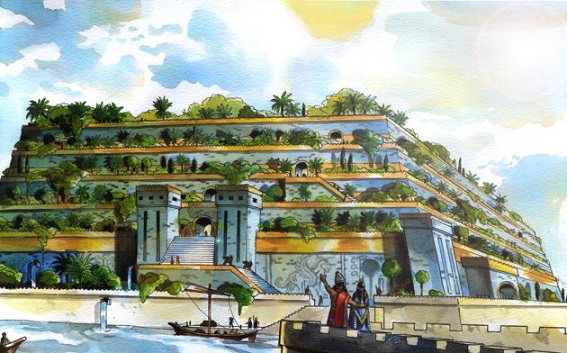
Location: Babylon City (modern Iraq)
Year of construction: Around
600 BC.
Function: Royal Gardens
Destroyed: Earthquake, 2nd
century BC
Size: Height is probably 24 meters.
Made of:
unbaked brick and lead for waterproofing
Other: Some
archaeologists suggest that the actual location of the Hanging
Gardens of Semiramis was not in Babylon, but 500 kilometers to the
north in the city of Nineveh, the capital of the Assyrian state.
The Hanging Gardens of Babylon or the Hanging Gardens of Amitis (or Semiramis from other sources) is one of the seven wonders of the world of the Ancient World. According to legend, a huge artificial hill was built by the Babylonian king Nebuchadnezzar II. Describing the ancient capital of Babylon, the ancient Greek historian Herodotus claimed that the perimeter of its outer walls reached 56 miles (about 89 km) in length, the walls reached 80 feet (30 meters) and 320 feet in height (about 100 meters). The walls of the Hanging Gardens of Semiramis were wide enough so that the two chariots harnessed by four horses could easily pass each other. The city also had internal walls that were "not so thick, but like the first were no less powerful." Inside these double walls stood gorgeous palaces and temples containing huge statues of pure gold. Towering over the city was the famous Tower of Babel, the temple of the god Marduk, who seemed to reach heaven, and of course the Hanging Gardens of Semiramis.
Archaeological excavations carried out in ancient Babylon dispute
some of Herodotus’s claims (the outer walls were 10 miles (16 km)
long and not so high). However, his story really gives us a sense of
how amazing the city was Babylon and what impression it made on
ancient people. Strangely enough, one of the most impressive sights
of the city was not even mentioned by Herodot, namely the Hanging
Gardens of Babylon or the Hanging Gardens of Semiramis, one of the
Seven Wonders of the Ancient World.
Hanging Gardens of
Babylon. Reconstruction
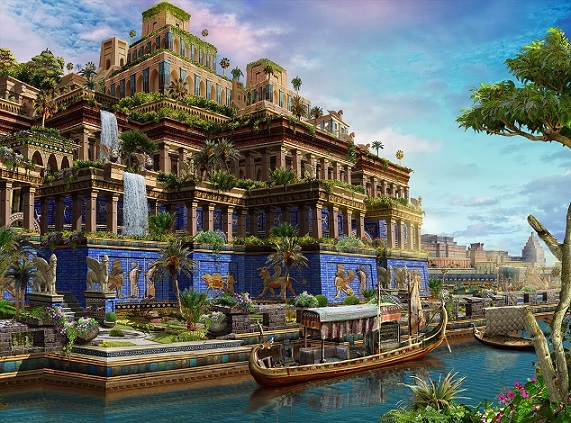
Historical records say that the Hanging Gardens of Babylon were
built by the king Nebuchadnezzar II, who ruled the city for 43
years, beginning in 605 BC. It was the height of the power and
influence of the city and the king Nebuchadnezzar himself, who, as
we know, built an amazing array of temples, streets, palaces and
walls. He particularly distinguished himself in the history of
Babylon for having defeated the Assyrian Empire, that twice took
Babylon and destroyed it. Together with Kiaksar, king of the Medes
(present-day Iraq, Iran, and part of Pakistan and Afghanistan), they
divided the Assyrian empire among themselves, and to support the
alliance Nebuchadnezzar II married Kiaksar’s daughter, Amitis or
Semiramis.
It is believed that Nebuchadnezzar built the
magnificent Hanging Gardens of Babylon for his homesick wife,
Amitis. Amitis, the daughter of the king of the Medes, married
Nebuchadnezzar to form an alliance between the two countries. Her
homeland was covered with green hills and mountains, and the area
around Babylon, of course, has no hills. The king decided to heal
her depression by recreating part of her homeland by creating an
artificial mountain with a garden.
There is an alternative
history that the Hanging Gardens of Semiramis were built by Assyrian
queen Semiramis or Shammuramat (812- 803 BC) during her five-year
reign. Although she was the wife of Assyrian king Shamshi-Adad V,
she was a Babylonian by blood.
The Hanging Gardens of Babylon
probably did not really "hang" in the sense that cables and ropes
were not used. The name comes from the incorrect translation of the
Greek word "kremastos" or the Latin "pensilis". Both words can be
translated as "hanging", as in the case of a terrace or balcony, and
does not hang in the truest sense of the word.
The Greek
geographer Strabo, who described the Hanging Gardens of Semiramis in
the first century BC, described the Gardens of Semiramis as follows:
The garden [of Semiramis] was quadrangular in shape, and each side was four plethra in length. It consists of arched arches, which are located one above the other, on the checkered, cubic columns. The checkered collections that were hollowed out are covered with a layer of deep earth, so that they allow the largest trees. Supports this all series of arches and arches. It is possible to climb the uppermost terrace by a ladder, next to this ladder there are screws with the help of which the workers appointed specifically for this purpose constantly raised water from the Euphrates to the garden. And the garden is on the river bank.
Strabo argued that the solution to the irrigation of the Hanging Gardens of Babylon was indeed the most amazing engineering problem that was solved by the ancients. Babylon is in a dry region, rain is not very frequent. To save the garden, trees and bushes had to be irrigated with water from the Euphrates River, which flowed through the city, dividing it into two parts. This meant that the water had to be raised to the very top, and from there it could flow through the canals to the terraces below. It was a huge task, given the lack of modern engines and pressure pumps in antiquity. We do not know exactly what these ancient devices, described by Strabo, looked like, but quite possibly they were some form of a “chain pump”. More details you can see the video which depicts the mechanism of its work.
The pump chain was stretched between two large wheels, one above
the other. Buckets hung on chains. Under the lower wheel there is a
pool with a water source. As the wheel turns, the buckets dipped
into the pool and took the water up. The chain then raises them to
the upper wheel, where the buckets poured water into the upper pool.
The chain then carried the empty buckets back down to repeat the
cycle.
From the upper pool of the garden, the water flowed
through the channels, creating artificial streams for watering the
garden. Pool doors were attached to the shaft with a handle. By
turning the knob, slaves could control the power of the stream.
An alternative method of obtaining water in the upper part of the
Hanging Gardens of Babylon, perhaps, was with a screw pump (shown in
the video). This device looks quite simple. A long tube was taken
with one end in the lower basin, from which water was pumped, and
from the other end, hanging over the upper basin, water poured out.
The water rose with the help of a long internal screw that was
tightly fit into the tube. As the screw turns, the water was clamped
between the propeller blades and was forced to rise to the top. When
the water reached the top, it fell into the upper pool.
Screw
pumps are very effective ways of moving water and a number of
engineers have suggested that they were used in hanging gardens.
Strabo even makes reference to his description of the part of the
garden, which can be taken as evidence that it was these manual
pumps that supplied water to the top. One of the problems with this
theory, however, is that we have little evidence that the
Babylonians had a screw pump. It is believed that the screw pump was
invented by the Greek engineer Archimedes from the Sicilian city of
Syracuse in 250 BC, more than 300 years after the construction of
the Hanging Gardens of Semiramis. However, let's not forget that the
Greeks are a proud people and could completely ignore the
achievements of other nations.
During the construction of the Gardens of Babylon, it was
necessary to take into account not only the severity of the water
supplied to the top, but also its destructive properties on the
structure itself. Since the stone was difficult to find on the
Mesopotamian plain, most of the buildings in Babylon were built of
brick. The bricks were made from clay mixed with chopped straw and
baked in the sun. Then they were connected by bitumen, a mucous
substance, which acted as a mortar. Unfortunately, water could
quickly ruin such bricks and the garden itself could quickly subside
under the action of moisture. As it was said, the rains in
Mesopotamia are rare, but the building into which so much water was
supplied from the Euphrates could indeed be destroyed in a few weeks
and months.
Diodorus Sicilian, a Greek historian,
described the platforms on which stood the Garden of Semiramis and
claimed that they consisted of huge stone slabs (apparently the only
stone structure in Babylon) covered with layers of reeds, asphalt
and tiles. Over it was
"a coating with sheets of lead that retained moisture that absorbed through the earth and allowed the foundation to be destroyed. The ground level was deep enough to grow the largest trees. When the soil was laid and leveled, all types of trees were planted in it, both for greatness and beauty , and maybe for the admiration of the audience. "
How big were the gardens of Semiramis? Diodorus tells us that they were about 400 feet wide by 400 feet (about 130 meters by 130 meters) in length and more than 80 feet high (25 meters). Other calculations show that the height was equal to the height of the outer city wall, given to us by Herodotus, which he claimed were a height of 320 feet (100 meters). In any case, the Hanging Gardens of Semiramis were an amazing sight: the green, artificial mountain clearly stood out from the plain.
In fact, everything that we know about gardens goes to us from ancient works. As we describe below, the very arrangement of the gardens has not yet been clarified. Let's start with the one who still built the Hanging Gardens of Babylon. Josephus (37-100 years AD) provides a description of the gardens, making reference to Berozus (or Beros), the Babylonian priest of the god Marduk, who lived around 290 BC. Beros described the reign of Nebuchadnezzar II and was the only source who claimed that it was Nebuchadnezzar II who built this miracle.
"In this palace he installed very high paths supported by stone pillars; and planted a garden, called it a hinged [Pensile] paradise, and replenished it with all kinds of trees, he made an exact resemblance of a mountainous country. He did this so that to appease her queen because she was raised in the Medes and also loved the mountain landscape "
Diodorus of Sicily (about 60-30 BC), made references to Clitarch (historian Alexander the Great) and Ctesias of Cnidus, who lived in 4 centuries BC. Diodorus attributes the construction to the Syrian king.
The park lasts for four pletters on each side, and since the approach to the garden is tilted, the slope of the hill and several parts of the structure grow from one another, the tier above the tier, the appearance as a whole resembled a theater. When the ascending terraces were built, galleries were built there that bore the brunt of the seeded garden; and the upper gallery, which was fifty cubits high, wore the highest platform of the park, which was made flush with the battlements of the city walls. In addition, the walls that were built for big money were twenty-two feet thick, while the passage between every two walls was ten feet wide. The bottom of the gardens was laid with a layer of reeds, laid in large quantities of bitumen, and a layer of baked brick bound with cement was put over these two layers, and the last layer was a coating of lead, so that moisture from the soil could not penetrate downwards. On all this, the earth was laid to a depth sufficient for the roots of the largest trees; the ground is leveled, densely planted with trees of every kind, which, in its large size or charm, could please the viewer. Galleries, each of which stands for one another, they all receive the light, and contain many royal havens of all stripes; there was also one gallery that contained holes leading to the upper surface and machines for watering the gardens, cars raising water in great abundance from the river, although no one outside could see how this was done. Now this park, as I said, was a late construction.
Where did Semiramis come from and was she a real character in the
history of the region? This seemingly simple question has no
definite answer. On the one hand, many historians identify Semiramis
with the Assyrian princess Shammuramat (812- 803 BC), but everything
is not so simple.
So the ancient authors narrate to us: "In
ancient times, the city of Ascalon was in Syria, and next to it was
a deep lake, where the temple of the goddess Atargatis (Atargatida,
also Derketo) stood." According to the myth, she fell from the sky
near Bambiki, and the fish that lived in the lake saved her. The
goddess, in gratitude, made the fish the constellation Pisces and
cemented in heaven. By the way, therefore, the temple dedicated to
Atargatide was made in the shape of a fish with a human head. The
goddess of love, Aphrodite, became angry with
Atargatis-Atargatida-Derketo and made her fall in love with a mere
mortal youth. Atargatis gave birth to a daughter, but irritated by
the unequal marriage, she killed the young man. The goddess left her
daughter and hid in the lake. Daughter Semiramis was left completely
alone. Local pigeons began to take care of the orphan. They warmed
the warmth of their body, and fed it with milk, and later cheese,
which they brought in their beaks. Later, the shepherds found the
baby, hearing her cry. They took the beautiful child and carried it
to Simmas, the caretaker of the royal herd. Simmas adopted Semiramis
("dove" in Syriac) and made her his daughter.
Semiramis grew
into a pretty girl. Onnes, the first royal adviser to the king Nina
and the governor of Syria, noticed the beauty, and of course fell in
love with her. He asked for the hand of her father Simmas and they
got married. In this marriage, she bore two sons. But beauty was not
the only virtue of a young woman. According to the legends, she had
a steel character and a wondrous mind. Needless to say, she had
complete authority over her husband Onnes.
At this time, the
enemies of Bactria attacked King Nina and Onnes and his wife went to
war. Their army consisted of 1,700,000 soldiers, 210,000 horsemen
and 10,600 war chariots. The army of Nineveh repulsed the troops of
Bactria and proceeded to the capital of Bactria. Despite his
superior strength, King Ning could not conquer the city. Semiramis
saw the opportunity to become famous. She arrived on the battlefield
in men's armor so that no one could recognize her gender. The writer
Diodorus, says that the dress was on the one hand very elegant, but
on the other hand it was not clear for him to understand the sex of
the warrior.
On the battlefield, Semiramide saw that the army
of Tsar Nin was attacking the weak sector of the capital of Bactria,
logically believing that it would be easier to win a military
victory there. The smart woman decided to take the risk and
suggested that there would be fewer people on the more protected
section of the walls and therefore it would be easy to capture this
section with a swift attack. Semiramida begged a small detachment of
soldiers from King Nina and she led the soldiers into battle. To the
great surprise of all, her risk was justified. The soldiers of
Bactria did not expect the Nineveh to venture into the most
protected part of the city. The enemy capital fell and Semiramis
became a hero of the army.
Of course, King Ning could not
pass by such a woman and demanded that his first adviser, Onnes,
cede his wife in peace. Onnes at first resisted, but the king scared
that he would poke out the eyes of the recalcitrant servant if he
did not see the needs of the lord. Moreover, in exchange for
Semiramis, the king promised to give his daughter Sosan. Poor Onnes
could not bear such grief, lost his mind and finally hanged himself.
And Semiramis became the queen and the wife of King Nin. King Ning
left his vicar in Bactria and returned to Nineveh with triumph. New
wife bore him a son Niniya.
Death of King Nina has two
versions. According to one version, Ning died his own death,
according to another his death was violent. According to the latest
version, King Ning decided to make a birthday present for
Semiramide. She asked to become the sole ruler for one day. The king
agreed and immediately paid his head. The insidious woman issued the
first decree according to which Nina was taken into the garden and
beheaded. So Semiramida became the only ruler of Nineveh and the
regent of the son - the heir Niniya.
The Hanging Gardens of Babylon are undoubtedly one of the most important buildings of Antiquity. However, if we look at the archaeological finds, we have very little evidence that they actually existed at all. In fact, ancient writers are all that remains of this magnificent building. We do not even have these gardens in the official archives of Babylon itself. Ancient clay tablets served as paper, and all important buildings in the city were written in cuneiform. However, they do not say anything about the gardens. They historians explained this by the fact that the gardens were part of the palace and therefore were not considered a separate building. Others suggested that the gardens were actually located in the capital of the Assyrian Empire, Nineveh. According to this alternative version, the Hanging Gardens of Semiramis were built in 700 BC. King Sennacherib or Ashur-Nazi-Apal II.
Stephanie Dalley, Assyriologist at the University of Oxford,
believes that the mistake was the result of the incorrect
translation of ancient works and the gardens themselves were located
500 km to the south in the city of Nineveh. King Sinaherib (705-680
BC) left a number of works describing luxurious gardens. He built
gardens with an extensive irrigation system. These written reports
vary widely from the archive of Nebuchadnezzar, which has no mention
of the gardens on its list of achievements in Babylon. Dally also
claims that the name "Babylon", which translates as "The Gate of the
Gods" was a name that could be applied to several Mesopotamian
cities. Sennacherib apparently renamed the city gates and dedicated
them to the gods, so that Nineveh was not considered Babylon,
creating confusion.
Interestingly, Sinaherib is the only
Mesopotamian king who left a message about his love for his wife - a
key part of the classic romantic story about the construction of
some hanging gardens:
And for Tashmetu-Sharat (Tashmetu-sharrat), the mistresses of the palace, my beloved wife, whose features raise above all other women, I had a palace of love, delight and joy, built by her
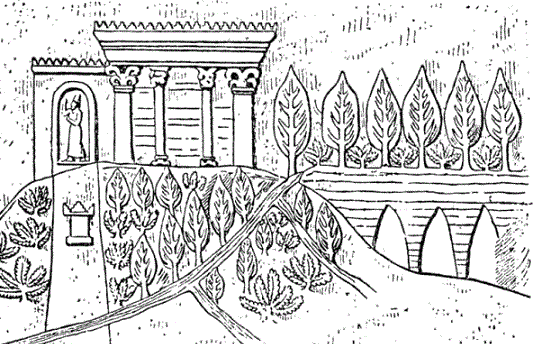
Assyrian garden image. As we can see part of the garden is located
on the aqueduct or platform, that is, they are mounted
Another possible candidate for the construction of the Hanging
Gardens was King Ashur-Nazi-Apal II (883-859 BC). He did not suffer
modesty and wrote a lot about his merits and successes:
I dug a canal from the Upper Zab River, running through the top of the mountain, and called it the Canal of Plenty. I watered Tiger meadows and planted fruit orchards with all kinds of fruit trees in the vicinity. I planted the seeds and plants that I found in the countries through which I marched and in the highlands I visited: pine of different species, cypress and juniper of different species, almond, date, ebony, rosewood, olive, oak, tamarisk, walnut, turpentine tree, spruce, pomegranate, pear, quince, fig, vine .... canal water beats the fountain from above into the garden; the aroma permeates the walkways, the streams of water are as numerous as the stars of the sky, in the pleasure garden .... As a squirrel, I choose fruits in the delight garden ...
There is another important reason why the structure of the gardens
was “transferred” to Babylon from Nineveh. The fact is that
Nebuchadnezzar II was the Babylonian king, victorious over the
Assyrians. Perhaps some of the gardens were really built in Babylon,
and already the king’s servants described them in such a way as to
overshadow everything the Assyrians could do. It is possible that
the legend of the hanging gardens was essentially stolen by the
winners along with gold and silver.
Is it possible that
the Greek scholars who wrote about the garden in Babylon for several
centuries could confuse these two different places? They were able
to confuse the Assyrian queen Semiramida or Shammuramat (812- 803
BC) with the Babylonian Amity. If the gardens really were in
Babylon, is it possible to find the remains to prove their
existence?
The German archaeologist Robert Koldevey spent a happy
archaeological excavation of ancient Babylon in 1899. For many
centuries, the ancient city was abandoned, and only imagined a pile
of dirty garbage never explored by scientists. Although unlike many
ancient places, the location of the city was well known, nothing was
left of the architecture. The stone was almost never used in the
structure, and clay bricks were destroyed for centuries. Koldewei
spent fourteen years and excavated most of the city, including the
outer walls of Babylon, the inner walls, the foundation of the Tower
of Babel, the palaces of Nebuchadnezzar and a wide street that runs
through the heart of the city.
During the excavations of
the Southern Citadel, Koldewei opened a basement with fourteen large
rooms with stone arched ceilings. Ancient records indicated that
only two places in the city used stone in their construction, on the
northern wall of the Northern Citadel, and in the construction of
the Hanging Gardens of Babylon. The northern wall of the Northern
Citadel has already been found, and a stone was actually found in
the building. This led Koldewey to the logical conclusion that he
had found the basement or lower tiers of the legendary garden of
Semiramis.
He continued to explore the neighborhood and
found many details that Diodorus reported. And finally, he unearthed
a room with three large, strange holes in the floor. Koldewei
concluded that it was the location of the chain pumps that lifted
the water to the roof of the Hanging Gardens of Semiramis.
While Koldewei was convinced that he had found the hanging
gardens of Semiramis, some modern archaeologists question his
discovery, arguing that this place is too far from the river. The
amount of water required for irrigation made this location extremely
inconvenient and not logical. Moreover, Strabo clearly states that
the garden should be located near the Euphrates River. In addition,
clay tables were discovered not long ago. They represent the royal
archive. Therefore, it was logical to assume that the place was used
for administrative and warehouse purposes, and not as a pleasure
garden of the Babylonian queen.
It is possible that the
Hanging Gardens of Babylon were under the river Euphrates. The fact
is that the river changed its course several times and it is quite
possible that the remains were absorbed by water. Unfortunately, at
present, archaeological excavations at the site of ancient Babylon
are not possible due to the fact that now there is actively
inculcating democracy or Sharia law, depending on the region.
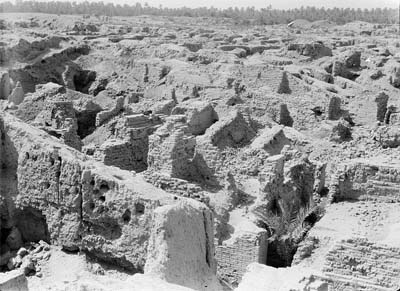
The ruins of the city of Babylon in 1932
If the Hanging
Gardens of Babylon really existed, what happened to them? There is a
report that they were destroyed by an earthquake in the second
century BC. The remnants of the Hanging Gardens of Babylon, mostly
of mud brick, were probably slowly eroded by infrequent rains over
the centuries.
Whatever the fate of the Hanging Gardens of
Babylon were, we can only guess if Queen Amitis was happy or if she
continued to yearn for the green mountains of her distant homeland.
He continued to explore the neighborhood and found many
details that Diodorus reported. And finally, he unearthed a room
with three large, strange holes in the floor. Koldewei concluded
that it was the location of the chain pumps that lifted the water to
the roof of the Hanging Gardens of Semiramis.
While
Koldewei was convinced that he had found the hanging gardens of
Semiramis, some modern archaeologists question his discovery,
arguing that this place is too far from the river. The amount of
water required for irrigation made this location extremely
inconvenient and not logical. Moreover, Strabo clearly states that
the garden should be located near the Euphrates River. In addition,
clay tables were discovered not long ago. They represent the royal
archive. Therefore, it was logical to assume that the place was used
for administrative and warehouse purposes, and not as a pleasure
garden of the Babylonian queen.
It is possible that the
Hanging Gardens of Babylon were under the river Euphrates. The fact
is that the river changed its course several times and it is quite
possible that the remains were absorbed by water. Unfortunately, at
present, archaeological excavations at the site of ancient Babylon
are not possible due to the fact that now there is actively
inculcating democracy or Sharia law, depending on the region.